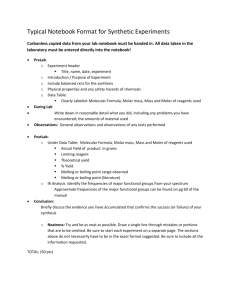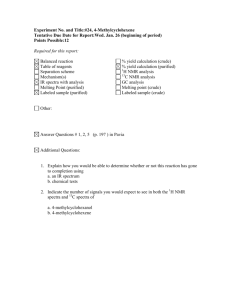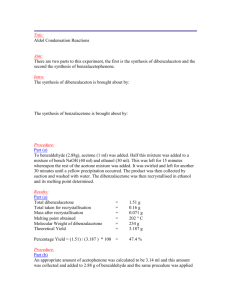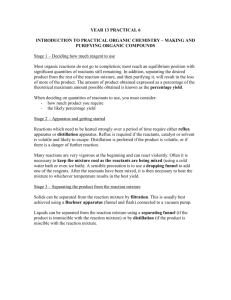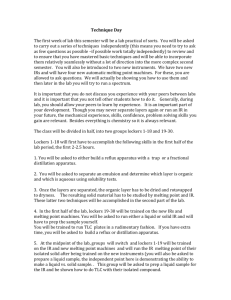Lab check in and review chem312
advertisement
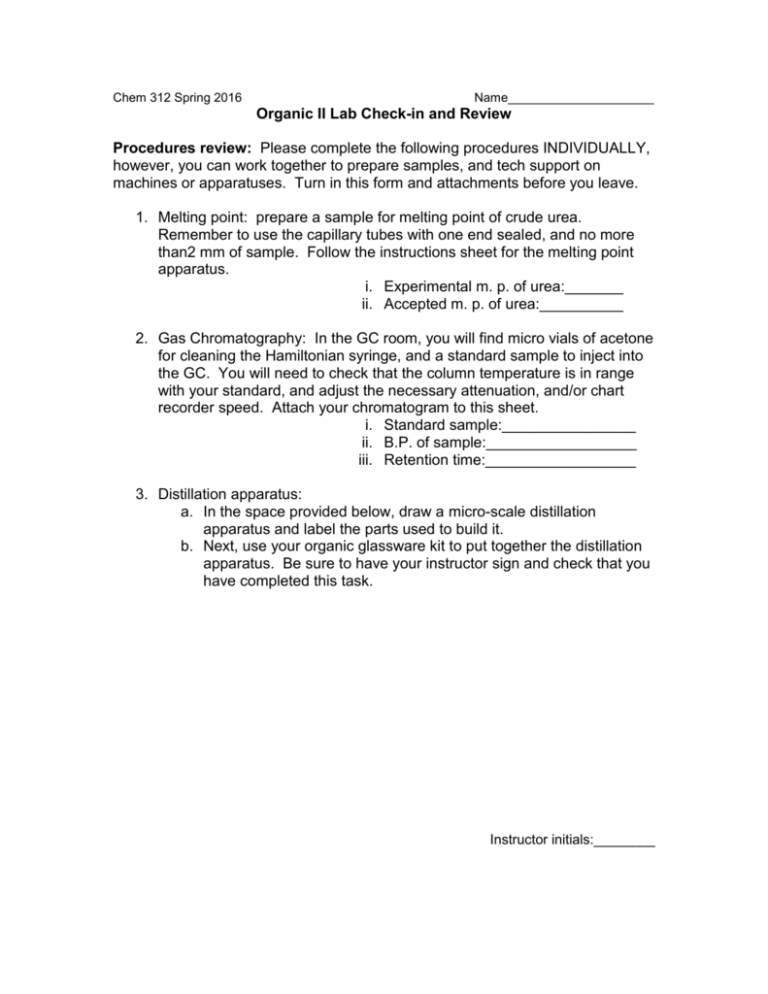
Chem 312 Spring 2016 Name_____________________ Organic II Lab Check-in and Review Procedures review: Please complete the following procedures INDIVIDUALLY, however, you can work together to prepare samples, and tech support on machines or apparatuses. Turn in this form and attachments before you leave. 1. Melting point: prepare a sample for melting point of crude urea. Remember to use the capillary tubes with one end sealed, and no more than2 mm of sample. Follow the instructions sheet for the melting point apparatus. i. Experimental m. p. of urea:_______ ii. Accepted m. p. of urea:__________ 2. Gas Chromatography: In the GC room, you will find micro vials of acetone for cleaning the Hamiltonian syringe, and a standard sample to inject into the GC. You will need to check that the column temperature is in range with your standard, and adjust the necessary attenuation, and/or chart recorder speed. Attach your chromatogram to this sheet. i. Standard sample:________________ ii. B.P. of sample:__________________ iii. Retention time:__________________ 3. Distillation apparatus: a. In the space provided below, draw a micro-scale distillation apparatus and label the parts used to build it. b. Next, use your organic glassware kit to put together the distillation apparatus. Be sure to have your instructor sign and check that you have completed this task. Instructor initials:________ Procedures (continued) 4. Recrystalization: using your lab textbook and on a separate sheet of paper, outline the steps necessary to recrystalize a compound using a microscale approach. 5. Thin Layer Chromatography: below you will find pictures of TLC plates, labeled A, B & C. Match A, B & C to the proper scenario below: a. _______ Shows a case where the solvent was too polar for the separation of the compounds. b. _______ Shows a case where the solvent was not polar enough to separate the compounds. c. _______ Shows a case of poor spotting technique. Safety Terms 1. Define the following terms and describe where you would find this information: Term Info MSDS PEL LD50 Melting and Boiling Point Density Solubility in water 2. For the following hazardous labels, define them, describe the personal protective gear you should wear, and where it is safe to use these items: Hazard Protective gear Where to use Corrosive Irritant Flammable Oxidizer Reusable items: Yes, No, True or false! Are the following items washable and reusable in the following scenarios? 1. Y N A weigh boat is used to weigh a mass of NaCl. 2. Y N A Pasteur pipette is used to transfer acetone from a graduated cylinder to a round bottom flask. 3. Y N A plastic dropper is used to transfer water from a beaker to a flask. 4. Y N A Pasteur pipette is used to make a micro-chromatography column. 5. Y N A glass TLC jar used in the resolution of plant pigments. 6. Y N A weigh boat used to mass a sample of hazardous solid. 7. Y N gloves after touching dirty glassware and stock bottles. 8. T F I should take the minimal amount needed from the stock bottle to my station. 9. T F If I have extra, I should offer it to another student before deciding to dump it in the appropriate waste container. 10. T F If I can’t figure out how to clean a piece of glassware, I should ask my instructor for help. (Acetone and a Kim wipe might work too.) Calculations: 1. Calculate the theoretical yield in mmol for the synthesis of aspirin from 0.500g Salicylic acid, C7H6O3, and 0.75mL of Acetic Anhydride, C4H6O3. 2. What is the % yield if 0.258g of crude aspirin was experimentally yielded from the reaction above? 3. What is the % recovery if all of the crude aspirin is purified and 0.202g is recovered after purification? 4. Use page 27 of the Lab text to list the following solvents in order of increasing polarity (use Polarity Index, P.I.): Acetic Acid, acetone, t-butyl methyl ether, ethanol, methanol, ethyl acetate, n-hexane, methylene chloride, toluene, water. 5. Lis the solvents in problem 4 above in order of increasing toxicity using P.E.L. values listed on page 27 of lab text. Physical and Experimental Data- For every experiment, you will be required to find physical data on the compounds you will be working with in the laboratory. You will also be required to quantify the success of the experiment via various calculations and physical data. Define the following terms, and provide an example for the terms that involve calculations*. 1. Molecular Mass 2. Density 3. Melting point 4. Boiling point 5. Refractive index 6. Solubility 7. Molarity* 8. Theoretical yield* 9. Actual yield 10. Percentage yield of an isolation* 11. Percentage yield of an organic synthesis* 12. Percentage recovery*

